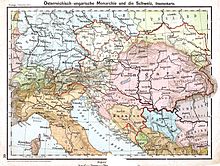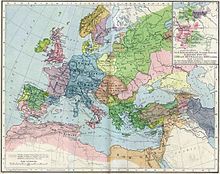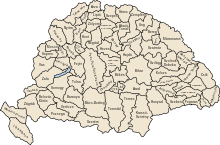Kingdom of Hungary
The Kingdom of Hungary ( Hungarian Magyar Királyság ) consisted of changing borders from 1000 to 1918 and 1920 to 1946. It originated in what is now western Hungary and subsequently expanded its territory to include all of today's Hungary as well as the area of Transylvania , the Kreisch area and Maramures (both in the Romanian part of the partium ), Slovakia , Vojvodina , the Romanian part of the Banat , Carpathian Ukraine , Burgenland , Prekmurje , Croatia (except Dalmatia and Istria ) and some smaller areas.
The kingdom has been under several foreign rule in its history and regained its sovereignty in 1867 as a federal (part) state of Austria-Hungary . After industrialization until the end of the First World War in 1918, the country had at times great influence on the politics of the major European powers and the domestic politics of Austria-Hungary. The geographical center of the former Kingdom of Hungary was in the Hungarian city of Szarvas .
etymology

The Hungarian name is Magyar Királyság , which literally means both "Hungarian Kingdom" and "Magyar Kingdom". The Czechs , Slovaks , Slovenes , Croats , Bosnians and Serbs , whose members lived in whole or in part or in the immediate vicinity of this multi-ethnic state , differentiate between “Hungarian” and “ Magyar ” in their languages when it comes to national and national names . For the multiethnic state before 1918, designations without ethnic assignment are used: Uhersko ( Czech ), Uhorsko ( Slovak ), Ogrska ( Slovenian ) and Ugarska / Угарска ( Croatian / Serbian ). The Magyar national state, as it emerged after 1918, is called in these languages, reflecting the ethnic Magyar character, Maďarsko (Czech and Slovak), Madžarska (Slovene) or Mađarska / Мађарска (Croatian / Serbian).
history
The first king of the kingdom was Stephen I the Saint from the ruling dynasty of the Árpáden , who was formally recognized as King of Hungary in 1001 when Pope Silvester II gave him the title of “Apostolic Majesty”. Stephan ruled until his death in 1038. In 1102 became King Koloman of Hungary by an agreement with the Croatian nobility ( pacta conventa ) in personal union also king of Croatia . The administration was taken over by Croatian Bane . The Árpád dynasty was followed by the Anjou dynasty in the early 14th century , and later the Jagiellonian dynasty and other non-dynastic rulers came to power.
In 1396 the Ottomans had to face a crusader army under the Hungarian king and later emperor Sigismund , who was defeated in the battle of Nicopolis .
The Ottoman Empire could derive little benefit from its victory, as Sultan Beyazid suffered a heavy defeat in the Battle of Ankara (1402) against Timur Lenk and was himself taken prisoner. This marked the beginning of a period of anarchy in the Ottoman Empire, which gave Constantinople, which was hard-pressed militarily by the Turks, a respite. It was not until the 1440s that the Kingdom of Hungary , which was now linked to Poland in a personal union, under Johann Hunyadi again became offensive on a large scale against the Ottomans. After the defeats at Varna (1444) and on the Amselfeld (1448), the initiative finally passed to the Ottomans, who soon took Constantinople (1453) and could only be temporarily stopped at Belgrade (1456).
János Hunyadi , who was regent and also military leader, fended off the siege of Belgrade by the Ottomans in 1456 and thus secured the country's independence for another 70 years. After his death, his son Matthias Hunyadi (1458–1490) was elected king, who became better known as Matthias Corvinus .
The European powers, first and foremost the Holy Roman Empire , which the Ottomans had not considered a serious threat for too long, were faced with the ruins of their policy concerning the Ottoman Empire at the latest with the fall of the medieval Kingdom of Hungary (1526). In the following decades it was therefore only a matter of preventing the Ottomans from advancing further in the direction of Central Europe.
The fall of the kingdom
In 1526 the decision in the fight against the Ottoman Empire followed in the battle of Mohács . The Hungarian King Ludwig II fell in battle. As a result, there were double elections in Hungary. On November 10, 1526, the Chair of Weissburg Landtag elected Johann Zápolya (ruled 1526–1540) as king. Archduke Ferdinand of Austria , who later became Emperor of the Holy Roman Empire , was elected as the new regent of Bohemia and Hungary by the Parliament of Pressburg on December 17, 1526 on the basis of an inheritance treaty concluded with the Habsburgs in 1515 . (The House of Habsburg actually retained the Hungarian royal dignity until the fall of the Habsburg monarchy in 1918, formally until the Hungarian law of dethronation in 1921.) In 1527 the Croatian Sabor in Cetin elected Archduke Ferdinand von Habsburg to be his king "completely free and without outside influence" .
The following Hungarian Civil War , in which John I was supported by the Turks, ended in 1538 with the Peace of Oradea . Johann Zápolya and Ferdinand were both allowed to continue to use the Hungarian royal title and dominate part of Hungary. After the death of Johann Zápolyas, this part of the country should fall to the House of Habsburg. After Johann Zápolya's death in 1540, a Hungarian parliament in Buda elected his son, Johann Sigismund Zápolya (ruled 1540–1570 / 71), who was a few weeks old, as the new Hungarian king. To forestall the Habsburg claims, Suleyman I intervened and occupied Buda and central Hungary. Hungary was divided into three parts after 1540 according to the established power relations. The exact demarcation between the individual parts varied considerably:
- The eastern territories became the Eastern Hungarian Kingdom under the rule of Johann Zápolya , the last national king of Hungary. Since his son designated himself in Latin as the ruler of parts (literally: partium ) of Hungary from 1570 , this term became common for the non-Transylvanian parts of the country that were under him. His successors later only had the principality of Transylvania , which was under Ottoman suzerainty as a vassal state.
- The remaining sovereign territory in the north and west (mostly today's Slovakia , Burgenland and western Croatia ) was under the Habsburgs since 1538. This area was called Royal Hungary and was integrated into the Habsburg Monarchy . In addition, this area continued the continuity of the Kingdom of Hungary during the period of Ottoman rule. This part of the country, like the Ottoman-occupied Hungary, was often the scene of the wars between the Ottoman Empire and the Habsburgs.
- The areas conquered by the Sultan became an integral part of the Ottoman Empire . The Ottoman Hungary consisted of the Great Hungarian Plain , which comprises the largest part of today's Hungary, including the Southeast Transdanubium and Banat .
In the centuries that followed there were many attempts to push back the Ottomans. Hungarian troops only played a role as supporters of one side or the other. The fate of Hungary was in the hands of the two neighboring great powers. Among other things, a coalition of Christian states fought against the Ottomans in the Austrian Turkish War ( Long Turkish War ) 1593–1606. After the war, the status quo was restored between the parties involved.
Along the border between the Christian and Ottoman parts of Hungary, two dense chains of fortifications emerged in the course of the 16th century. There were often clashes and skirmishes between the garrisons , even in times of relative calm. As a result, the surrounding area was permanently devastated and resettlement was made difficult.
Restoration of the Kingdom
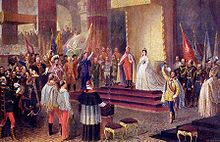
After the Habsburgs and their allies pushed the Ottoman Empire back to the areas south of the Danube and the Sava and fixed this in the Peace of Karlowitz in 1699 , the Kingdom of Hungary, which had never disappeared de jure, was de facto restored. (The struggle with the Ottoman Empire was far from over.) Some German and other immigrants were settled in the areas depopulated by war, called by the Habsburg king.
In 1848/1849 there was a great struggle between the awakened Magyar nationalism and the Habsburg royal house, which pursued a supranational concept (see Hungarian Revolution 1848/1849 , Revolution 48/49 in the Austrian Empire ). In the long run, Lajos Kossuth and his fellow combatants had no chance against the armies of Austria and the Russian Empire called for help by the king . What had been an uprising from the Habsburgs' point of view was brutally suppressed; Magyar leaders who had not fled were executed . After that, Hungary was administered like a colony for fifteen years , to which the residents, as far as possible, offered passive resistance . In particular, the Hungarian political class refused to send representatives to designated state institutions.
From 1859 the Austrian Empire suffered several military defeats and territorial losses:
- 1859 Sardinian War - Loss of Lombardy
- After this defeat of Austria, the rule of the Habsburgs also collapsed in the duchies of Parma , Modena and Tuscany , which joined Sardinia after the revolutionary upheavals.
- In the German War of 1866, in which Italy stood on the side of Prussia, Veneto fell to Italy (despite less of its own Italian military successes, except for Bezzecca and Monzambano ).
On August 23, 1866, the German Confederation , which had existed since 1815, was dissolved in the Definitive Peace of Prague . All of this led Franz Joseph I and his advisors to abandon the idea of a unitary state in order to end Hungary's passive resistance to the Vienna government. They were now ready to respect Hungary's own constitutional identity: in 1867 the Austro- Hungarian dual monarchy was established. In the Austro-Hungarian settlement , the Austrian dominance in the Danube monarchy was ended and the entire Habsburg monarchy was transformed into a real union of two states: the Austrian Empire and the “Kingdom of Hungary”, which no longer belonged to it (officially countries of the Holy Hungarian Crown of St. Stephen ). The monarch set Austria-Hungary (or Austro-Hungarian monarchy) as the name in 1868 . The ruler was now the owner of two equivalent issues: K aiser of Austria u nd Apostolic K önig of Hungary in personal union .
In Transleithanien , as the Hungarian half of the empire was often called in official German , it was only after a systematic and bureaucratically violent Magyarization campaign at the end of the 19th century that a (still scarce) Magyar majority succeeded. The Magyars, who always claimed political prerogatives, were in the minority in their kingdom for most of their history. Especially in the late phase of the dual monarchy, Hungarian politicians used almost every opportunity to pursue a separatist policy against imperial Austria; for example, they persistently (but unsuccessfully) demanded the division of the Common Army .
Kingdom without a king
The Austro-Hungarian monarchy existed until its defeat in World War I , when Hungary terminated the Real Union on October 31, 1918. A little later the (People's) Republic of Hungary was proclaimed, and in 1920 the “Kingdom without a King” was established. The Kingdom of Hungary was therefore the official (but otherwise not in use) name of the Hungarian state, which in terms of area largely corresponded to today's Hungary and existed from March 21, 1920 to December 21, 1944.
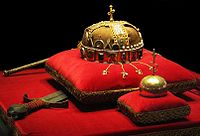
During this time, the country was ruled by the Reich Administrator Miklós Horthy until October 16, 1944 ; this acted as the king's deputy (see Truchsess ) during the king's absence. In the Treaty of Trianon 1920, the government in Budapest had to accept the abandonment of the non-Magyar regions of "Old Hungary", which had largely taken place in 1918/1919, which also made many Magyars living there foreigners; the borders had been drawn with strategic generosity to the detriment of the loser. In 1921 Horthy torpedoed two attempts by King Charles IV , who on November 13, 1918, had renounced any share in the affairs of state to return to the throne. In the Dethronization Act of November 6, 1921, which the suspicious new neighbors Czechoslovakia , Romania and Yugoslavia had demanded, the House of Habsburg in Hungary was definitively dethroned.
Before and during World War II , Horthy supported the “ Third Reich ”; Hungary temporarily regained Magyar settled areas in southern Slovakia , Transylvania and large parts of Vojvodina and sent combat troops to the eastern front. When the Reichsverweser no longer proved to be a reliable supporter of Adolf Hitler in 1944 , the fictional kingdom of the Arrow Crossers was replaced by a fascist state. The Hungarian royal crown , taken away by Hungarian politicians fleeing the Red Army and confiscated by US soldiers in Austria, did not return to Budapest from the USA until decades later .
population
The population by colloquial language according to the census (excluding Croatia-Slavonia ):
| 1851 | 1880 | 1890 | 1900 | 1910 | |
|---|---|---|---|---|---|
| Hungarian | 4,807,453 (42.3%) | 6,403,687 (46.5%) | 7,356,874 (48.6%) | 8,651,520 (51.4%) | 9,944,627 (54.5%) |
| Romanian | 2,126,004 (18.7%) | 2,403,035 (17.5%) | 2,589,066 (17.1%) | 2,798,559 (16.6%) | 2,948,186 (16.1%) |
| Slovak | 1,729,919 (15.2%) | 1,855,442 (13.5%) | 1,896,641 (12.5%) | 2,002,165 (11.9%) | 1,946,357 (10.7%) |
| German | 1,310,874 (11.5%) | 1,869,877 (13.6%) | 1,988,589 (13.1%) | 1,999,060 (11.9%) | 1,903,357 (10.4%) |
| Serbian | 446,926 (3.9%) | 631,995 (4.6%) | 495,105 (3.3%) | 437,737 (2.6%) | 461,516 (2.5%) |
| Ruthenian | 447,377 (3.9%) | 353,226 (2.6%) | 379,782 (2.5%) | 424,774 (2.5%) | 464,270 (2.5%) |
| Croatian | 74,786 (0.7%) | - | 183,642 (1.2%) | 191,432 (1.1%) | 194,808 (1.1%) |
| Slovenian | 44,862 (0.4%) | 63,261 (0.5%) | 70,912 (0.5%) | 79,066 (0.5%) | 77,398 (0.4%) |
| total | 11,363,955 | 13,728,622 | 15.133.494 | 16,838,255 | 18,264,533 |
(Data for 1851 including Transylvania, as well as Vojvodschaft Serbia and Temescher Banat. In 1880 Croatian and Serbian were added together.)
Religious relationships in 1900 :
- Roman Catholic: 8,198,497 (48.7%)
- Protestant HB: 2,427,232 (14.4%)
- Greek Orthodox: 2,199,195 (13.1%)
- Greek Catholic: 1,841,272 (10.9%)
- Protestant AB: 1,258,860 (7.5%)
- Israelite: 831,162 (4.9%)
- unitarian: 68,551 (0.4%)
See also
- List of historical counties of Hungary
- List of the kings of Hungary
- Greater Hungary
- Hungarian Reichstag
literature
- Pál Engel: The Realm of St Stephen. A History of Medieval Hungary, 895-1526. IB Tauris, London / New York 2001.
- Geza Palffy: The Kingdom of Hungary and the Habsburg Monarchy in the Sixteenth Century. Columbia University Press, New York 2009.
- Miklós Molnár : History of Hungary. From the beginning to the present. Krämer, Hamburg 2004.
Individual evidence
- ↑ a b Klaus-Peter Matschke: The cross and the half moon. The history of the Turkish wars . Artemis & Winkler, 2004
- ^ Peter F. Sugar, Péter Hanák, Tibor Frank: A History of Hungary , p. 85.
- ^ André Corvisier, John Childs: A dictionary of military history and the art of war, p. 366.

